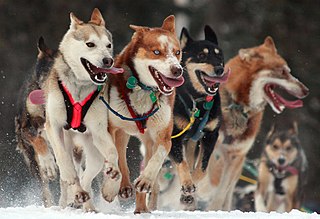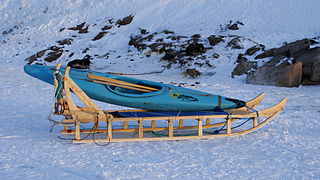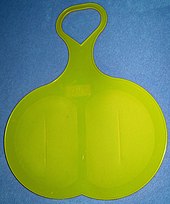
A kayak is a small, narrow human-powered watercraft typically propelled by means of a long, double-bladed paddle. The word kayak originates from the Greenlandic word qajaq.

Winter sports or winter activities are competitive sports or non-competitive recreational activities which are played on snow or ice. Most are variations of skiing, ice skating and sledding. Traditionally, such games were only played in cold areas during winter, but artificial snow and artificial ice allow more flexibility. Playing areas and fields consist of either snow or ice.

Bobsleigh or bobsled is a winter sport in which teams of 2 to 4 athletes make timed runs down narrow, twisting, banked, iced tracks in a gravity-powered sleigh. International bobsleigh competitions are governed by the International Bobsleigh and Skeleton Federation.

Ice skates are metal blades attached underfoot and used to propel the bearer across a sheet of ice while ice skating.

The Innu / Ilnu or Innut / Innuat / Ilnuatsh ("people"), formerly called Montagnais from the French colonial period, are the Indigenous inhabitants of territory in the northeastern portion of the present-day province of Labrador and some portions of Quebec. They refer to their traditional homeland as Nitassinan or Innu-assi.

Snowshoes are specialized outdoor gear for walking over snow. Their large footprint spreads the user's weight out and allows them to travel largely on top of rather than through snow. Adjustable bindings attach them to appropriate winter footwear.

A sled, skid, sledge, or sleigh is a land vehicle that slides across a surface, usually of ice or snow. It is built with either a smooth underside or a separate body supported by two or more smooth, relatively narrow, longitudinal runners similar in principle to skis. This reduces the amount of friction, which helps to carry heavy loads.

A snowmobile, also known as a snowmachine, motor sled, motor sledge, skimobile, or snow scooter, is a motorized vehicle designed for winter travel and recreation on snow. It is designed to be operated on snow and ice and does not require a road or trail, but most are driven on open terrain or trails. Snowmobiling is a sport that many people have taken on as a serious hobby. Common brand names in the United States include Arctic Cat, Polaris Inc. and Ski-Doo.

Sledding, sledging or sleighing is a winter sport typically carried out in a prone or seated position on a vehicle generically known as a sled, a sledge (British), or a sleigh. It is the basis of three Olympic sports: luge, skeleton and bobsledding. When practised on sand, it is known as a form of sandboarding. In Russia sledges are used for maritime activities including fishing and commuting from island to island on ice.

Mushing is a sport or transport method powered by dogs. It includes carting, pulka, dog scootering, sled dog racing, skijoring, freighting, and weight pulling. More specifically, it implies the use of one or more dogs to pull a sled, most commonly a specialized type of dog sled on snow, or a rig on dry land.

The Cresta Run is a natural ice skeleton racing toboggan track in eastern Switzerland. Located in the winter sports town of St. Moritz, the 1.2125 km (0.753 mi) run is one of the few in the world dedicated entirely to skeleton. It was built in 1884 near the hamlet of Cresta in the municipality of Celerina/Schlarigna by the Outdoor Amusement Committee of the Kulm Hotel and the people of St. Moritz. The committee members were Major William Henry Bulpett, George Robertson, Charles Digby Jones, C. Metcalfe, and J. Biddulph. It has continued as a partnership to this day between the SMTC, founded in 1887, and the people of St. Moritz.

A pulk is a Nordic short, low-slung small sled used in sport or for transport, pulled by a dog or a skier, or in Sápmi pulled by reindeer. They are classically made out of wood and other natural materials but are nowadays made of plastic, which makes them inexpensive.

Korketrekkeren is a tobogganing track and former bobsleigh and luge track in Oslo, Norway. The tobogganing track runs between Frognerseteren and Midtstuen and is operated as a public venue by the municipality. Return transport to the top of the hill is undertaken by riding the Oslo Metro's Holmenkollen Line. Tobogganing in the area started in the 1880s, with several roads being used during winter evenings. Auto racing took place in the hill in 1921 and the following year it saw its first luge tournament. The first major tournament was the FIL European Luge Championships 1937. Tobagganing also took place in the nearby Heftyebakken, but from 1950 Korketrekkeren became the sole tobogganing hill and Heftyebakken was used for cross-country skiing.

An Aerosledge is a propeller-driven sledge, sleigh or toboggan which slides on runners or skis. Aerosleds are used for communications, mail deliveries, medical aid, emergency recovery, and patrolling borders in countries such as northern Russia, as well as for recreation. Aerosani were used by the Soviet Red Army during the Winter War and World War II.

The Atikamekw are an Indigenous people in Canada. Their historic territory, Nitaskinan, is in the upper Saint-Maurice River valley of Quebec. One of the main communities is Manawan, about 160 kilometres (99 mi) northeast of Montreal.
The Camden Snow Bowl is a small, town-owned ski area in Camden, Maine. Located about 4.5 miles (7.2 km) from Penobscot Bay on the eastern slope of Ragged Mountain. It also features a toboggan run on which the U.S. National Toboggan Championships are hosted annually. During the summer, visitors are able to hike, mountain bike, or boat and fish.

A summer toboggan is an amusement or recreational ride which uses a bobsled-like sled or cart to run down a track usually built on the side of a hill. There are two main types: an Alpine coaster or mountain coaster is a type of roller coaster where the sled runs on rails and is not able to leave the track, whereas with an Alpine slide the sled simply runs on a smooth concave track usually made of metal, concrete or fiberglass. Both of these types of ride are sometimes denoted with the German name Sommerrodelbahn.

A rescue toboggan, also known as a rescue sled or emergency rescue sledge, or by the Finnish word ahkio, is a carrier for transporting a person or goods on snowy or icy surfaces. It is used by mountain rescue or ski patrol teams to evacuate an injured skier or snowboarder. There are related designs for use on water to carry accident victims or emergency equipment.

A qamutiik is a traditional Inuit sled designed to travel on snow and ice. It is built using traditional Inuit design techniques and is still used in the 21st century for travel in Arctic regions.

A mud sledge is a sled used to cross mud flats such as estuaries and bays.





















